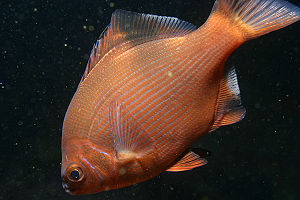Surfperch
Surfperch is a common name for a family of marine fish in the family Embiotocidae, which are native to the Pacific Ocean along the coasts of North America and Asia. These fish are known for their vibrant colors and the unique characteristic of giving birth to live young, a trait known as viviparity, which is relatively rare among fish. Surfperches are a popular target for recreational fishing, especially from piers and rocky shores.
Description[edit | edit source]
Surfperch species vary in size and coloration, but most have laterally compressed bodies, making them appear thin when viewed head-on. They typically have small mouths and large, often colorful fins. The size of surfperch can range from small, at just a few inches in length, to larger species that can reach up to a foot (30 cm) or more.
Habitat[edit | edit source]
Surfperch inhabit the nearshore waters of the Pacific, often found in and around kelp beds, rocky shores, and piers. They are most commonly found in shallow waters, although some species may venture into deeper waters. Their habitats range from the cold waters off Alaska to the warmer waters of Baja California.
Reproduction[edit | edit source]
One of the most notable aspects of surfperch biology is their reproductive system. Unlike most fish, which lay eggs, surfperch give birth to live young. This viviparous reproduction system involves the female retaining the fertilized eggs inside her body until they hatch, at which point she gives birth to fully formed, free-swimming juveniles. This strategy provides the young with a higher chance of survival than those of egg-laying species, as they are born in a more advanced state of development.
Diet[edit | edit source]
Surfperch feed on a variety of small invertebrates, including crustaceans, mollusks, and sometimes small fish. Their diet varies with the availability of prey in their habitat.
Fishing and Conservation[edit | edit source]
Surfperch are a popular target for anglers, particularly those fishing from piers and beaches. They are known for their fight when hooked, making them a favorite among sport fishermen. Despite their popularity, most surfperch populations are considered stable. However, like all marine species, they face threats from overfishing, habitat loss, and pollution. Conservation efforts focus on maintaining healthy populations through sustainable fishing practices and habitat protection.
This marine-related article is a stub. You can help WikiMD by expanding it.
Search WikiMD
Ad.Tired of being Overweight? Try W8MD's physician weight loss program.
Semaglutide (Ozempic / Wegovy and Tirzepatide (Mounjaro / Zepbound) available.
Advertise on WikiMD
|
WikiMD's Wellness Encyclopedia |
| Let Food Be Thy Medicine Medicine Thy Food - Hippocrates |
Translate this page: - East Asian
中文,
日本,
한국어,
South Asian
हिन्दी,
தமிழ்,
తెలుగు,
Urdu,
ಕನ್ನಡ,
Southeast Asian
Indonesian,
Vietnamese,
Thai,
မြန်မာဘာသာ,
বাংলা
European
español,
Deutsch,
français,
Greek,
português do Brasil,
polski,
română,
русский,
Nederlands,
norsk,
svenska,
suomi,
Italian
Middle Eastern & African
عربى,
Turkish,
Persian,
Hebrew,
Afrikaans,
isiZulu,
Kiswahili,
Other
Bulgarian,
Hungarian,
Czech,
Swedish,
മലയാളം,
मराठी,
ਪੰਜਾਬੀ,
ગુજરાતી,
Portuguese,
Ukrainian
Medical Disclaimer: WikiMD is not a substitute for professional medical advice. The information on WikiMD is provided as an information resource only, may be incorrect, outdated or misleading, and is not to be used or relied on for any diagnostic or treatment purposes. Please consult your health care provider before making any healthcare decisions or for guidance about a specific medical condition. WikiMD expressly disclaims responsibility, and shall have no liability, for any damages, loss, injury, or liability whatsoever suffered as a result of your reliance on the information contained in this site. By visiting this site you agree to the foregoing terms and conditions, which may from time to time be changed or supplemented by WikiMD. If you do not agree to the foregoing terms and conditions, you should not enter or use this site. See full disclaimer.
Credits:Most images are courtesy of Wikimedia commons, and templates Wikipedia, licensed under CC BY SA or similar.
Contributors: Prab R. Tumpati, MD

